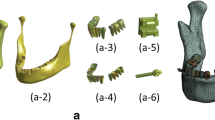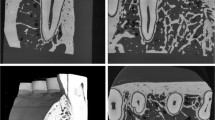Abstract
This paper aims at investigating mechanical behaviors of maxilla, teeth and mandible. There are three models considered; a model of one tooth with mandible subjected to coronal-apical, lingual-buccal and mesial-distal directional pressures, a model of an upper, a lower tooth with mandible and part of maxilla subjected to mandible displacements in coronal-apical, lingual-buccal and mesialdistal directions, and a model of three upper and two lower teeth with mandible and part of maxilla subjected to mandible displacements in coronal-apical direction. FE models of teeth, part of maxilla and mandible are generated based on CT images. Material properties for teeth, PDL, cortical bone, and cancellous bone are applied to the corresponding parts. From the analyses of one tooth model, von Mises stress distributions are obtained and compared with the previously reported data for validation of modeling approaches. Those are then applied to models with multiple teeth to examine effect of directions of mandible movement and interactions. Analytical results show that geometries of teeth and directions of masticatory movement can cause significant differences in stress distributions. It is suggested that importance of parameters to be considered in predicting mechanical behaviors under masticatory action, and provide useful information for developing prosthetic devices or diagnosis.
Similar content being viewed by others

References
Kowalczyk, P., “Influence of the Shape of the Layers in Photo-Cured Dental Restorations on the Shrinkage Stress Peaks-FEM Study,” Dental Materials, Vol. 25, No. 12, pp. e83–e91, 2009.
Magne, P., “Efficient 3D Finite Element Analysis of Dental Restorative Procedures Using Micro-CT Data,” Dental Materials, Vol. 23, No. 5, pp. 539–548, 2007.
Magne, P. and Tan, D. T., “Incisor Compliance Following Operative Procedures: A Rapid 3-D Finite Element Analysis using Micro-CT Data,” Journal of Adhesive Dentistry, Vol. 10, No. 1, pp. 49–56, 2008.
Boschian Pest, L., Guidotti, S., Pietrabissa, R., and Gagliani, M., “Stress Distribution in a Post-Restored Tooth using the Three-Dimensional Finite Element Method,” Journal of Oral Rehabilitation, Vol. 33, No. 9, pp. 690–697, 2006.
Cruz, M., Wassall, T., Toledo, E. M., da Silva Barra, L. P., and Cruz, S., “Finite Element Stress Analysis of Dental Prostheses Supported by Straight and Angled Implants,” International Journal of Oral & Maxillofacial Implants, Vol. 24, No. 3, pp. 391–401, 2009.
Karl, M., Graef, F., Heckmann, S., and Taylor, T., “A Methodology to Study the Effects of Prosthesis Misfit Over Time: an in vivo Model,” International Journal of Oral & Maxillofacial Implants, Vol. 24, No. 4, pp. 689–694, 2009.
Ichim, I., Swain, M. V., and Kieser, J. A., “Mandibular Stiffness in Humans: Numerical Predictions,” Journal of biomechanics, Vol. 39, No. 10, pp. 1903–1913, 2006.
Tanaka, E., Yamano, E., Dalla-Bona, D., Watanabe, M., Inubushi, T., et al., “Dynamic Compressive Properties of the Mandibular Condylar Cartilage,” Journal of Dental Research, Vol. 85, No. 6, pp. 571–575, 2006.
Daumas, B., Xu, W., and Bronlund, J., “Jaw Mechanism Modeling and Simulation,” Mechanism and Machine Theory, Vol. 40, No. 7, pp. 821–833, 2005.
Xu, W. L., Pap, J.-S., and Bronlund, J., “Design of a Biologically Inspired Parallel Robot for Foods Chewing,” IEEE Transactions on Industrial Electronics, Vol. 55, No. 2, pp. 832–841, 2008.
Eser, A., Akca, K., Eckert, S., and Cehreli, M. C., “Nonlinear Finite Element Analysis Versus Ex vivo Strain Gauge Measurements on Immediately Loaded Implants,” International Journal of Oral & Maxillofacial Implants, Vol. 24, No. 3, pp. 439–446, 2009.
Tanaka, E. and Van Eijden, T., “Biomechanical Behavior of the Temporomandibular Joint Disc,” Critical Reviews in Oral Biology & Medicine, Vol. 14, No. 2, pp. 138–150, 2003.
Hattori, Y., Satoh, C., Kunieda, T., Endoh, R., Hisamatsu, H., and Watanabe, M., “Bite Forces and their Resultants during Forceful Intercuspal Clenching in Humans,” Journal of Biomechanics, Vol. 42, No. 10, pp. 1533–1538, 2009.
Sato, H., Kawamura, A., Yamaguchi, M., and Kasai, K., “Relationship between Masticatory Function and Internal Structure of the Mandible based on Computed Tomography Findings,” American Journal of Orthodontics and Dentofacial Orthopedics, Vol. 128, No. 6, pp. 766–773, 2005.
Masumoto, T., Hayashi, I., Kawamura, A., Tanaka, K., and Kasai, K., “Relationships among Facial Type, Buccolingual Molar Inclination, and Cortical Bone Thickness of the Mandible,” The European Journal of Orthodontics, Vol. 23, No. 1, pp. 15–23, 2001.
Asmussen, E., Peutzfeldt, A., and Sahafi, A., “Finite Element Analysis of Stresses in Endodontically Treated, Dowel-Restored Teeth,” The Journal of Prosthetic Dentistry, Vol. 94, No. 4, pp. 321–329, 2005.
Park, S., Chae, S.-W., Park, J., Han, S.-H., Hong, J., and Kim, Y. E., “Finite Element Modeling to Estimate the Apparent Material Properties of Trabecular Bone,” Int. J. Precis. Eng. Manuf., Vol. 14, No. 8, pp. 1479–1485, 2013.
Kang, K.-T., Kim, H.-J., Son, J., Yeom, J. S., and Chun, H.-J., “Comparing an Instrumented Posterior Fixation System with Rigid and Semi-Flexible Rods using Finite Element Analysis,” Int. J. Precis. Eng. Manuf., Vol. 16, No. 1, pp. 163–170, 2015.
Kim, H.-S., Park, J.-Y., Kim, N.-E., Shin, Y.-S., Park, J.-M., and Chun, Y.-S., “Finite Element Modeling Technique for Predicting Mechanical Behaviors on Mandible Bone during Mastication,” The Journal of Advanced Prosthodontics, Vol. 4, No. 4, pp. 218–226, 2012.
Merdji, A., Mootanah, R., BouiadJra, B. A. B., Benaissa, A., Aminallah, L., and Mukdadi, S., “Stress Analysis in Single Molar Tooth,” Materials Science and Engineering: C, Vol. 33, No. 2, pp. 691–698, 2013.
Gomes de Oliveira, S., Seraidarian, P. I., Landre, J., Oliveira, D. D., and Cavalcanti, B. N., “Tooth Displacement due to Occlusal Contacts: A Three-Dimensional Finite Element Study,” Journal of Oral Rehabilitation, Vol. 33, No. 12, pp. 874–880, 2006.
Kasai, K., Takayama, Y., and Yokoyama, A., “Distribution of Occlusal Forces during Occlusal Adjustment of Dental Implant Prostheses: A Nonlinear Finite Element Analysis Considering the Capacity for Displacement of Opposing Teeth and Implants,” International Journal of Oral & Maxillofacial Implants, Vol. 27, No. 2, pp. 329–335, 2012.
Eraslan, Ö., Eraslan, O., Eskitascioglu, G., and Belli, S., “Conservative Restoration of Severely Damaged Endodontically Treated Premolar Teeth: A FEM Study,” Clinical Oral Investigations, Vol. 15, No. 3, pp. 403–408, 2011.
Marinescu, R., Daegling, D. J., and Rapoff, A. J., “Finite-Element Modeling of the Anthropoid Mandible: The Effects of Altered Boundary Conditions,” The Anatomical Record Part A: Discoveries in Molecular, Cellular, and Evolutionary Biology, Vol. 283, No. 2, pp. 300–309, 2005.
Wang, Q., Smith, A. L., Strait, D. S., Wright, B. W., Richmond, B. G., et al., “The Global Impact of Sutures Assessed in a Finite Element Model of a Macaque Cranium,” The Anatomical Record, Vol. 293, No. 9, pp. 1477–1491, 2010.
Fitton, L., Shi, J., Fagan, M., and O’Higgins, P., “Masticatory Loadings and Cranial Deformation in Macaca Fascicularis: A Finite Element Analysis Sensitivity Study,” Journal of Anatomy, Vol. 221, No. 1, pp. 55–68, 2012.
Young, M. T., Rayfield, E. J., Holliday, C. M., Witmer, L. M., Button, D. J., et al., “Cranial Biomechanics of Diplodocus (Dinosauria, Sauropoda): Testing Hypotheses of Feeding Behaviour in an Extinct Megaherbivore,” Naturwissenschaften, Vol. 99, No. 8, pp. 637–643, 2012.
Baek, S.-H., Cha, H.-S., Cha, J.-Y., Moon, Y.-S., and Sung, S.-J., “Three-Dimensional Finite Element Analysis of the Deformation of the Human Mandible: A Preliminary Study from the Perspective of Orthodontic Mini-Implant Stability,” The Korean Journal of Orthodontics, Vol. 42, No. 4, pp. 159–168, 2012.
Cook, R. D., Malkus, D. S., Plesha, M. E, and Witt, R. J., “Concepts and Applications of Finite Element Analysis,” Wiley, 4th Ed., pp. 259–268, 1989.
Wierszycki, M., K¸akol, W., and £odygowski, T., “The Screw Loosening and Fatigue Analyses of Three Dimensional Dental Implant Model,” Proc. of ABAQUS Users’ Conference, pp. 527–541, 2006.
Correia, A. R., Piloto, P., Campos, J. C. R., and Vaz, M., “Finite Element Analysis of the Mechanical Behavior of a Partially Edentulous Mandible as a Function of Cancellous Bone Density,” Revista Odonto Ciência, Vol. 24, No. 1, pp. 22–27, 2008.
Xu, W. L., Bronlund, J. E., Potgieter, J., Foster, K. D., Röhrle, O., et al., “Review of the Human Masticatory System and Masticatory Robotics,” Mechanism and Machine Theory, Vol. 43, No. 11, pp. 1353–1375, 2008.
Savoldelli, C., Bouchard, P.-O., Loudad, R., Baque, P., and Tillier, Y., “Stress Distribution in the Temporo-Mandibular Joint Discs during Jaw Closing: A High-Resolution Three-Dimensional Finite-Element Model Analysis,” Surgical and Radiologic Anatomy, Vol. 34, No. 5, pp. 405–413, 2012.
Author information
Authors and Affiliations
Corresponding author
Rights and permissions
About this article
Cite this article
Kim, HS., Lee, YK. & Park, JY. Development of FEA procedures for mechanical behaviors of maxilla, teeth and mandible. Int. J. Precis. Eng. Manuf. 17, 785–792 (2016). https://doi.org/10.1007/s12541-016-0096-7
Received:
Revised:
Accepted:
Published:
Issue Date:
DOI: https://doi.org/10.1007/s12541-016-0096-7



